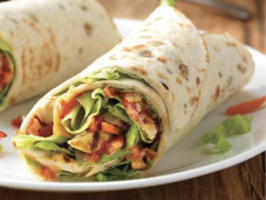
by Rabbi Avraham Chaim Bloomenstiel
Q: What is the correct bracho on a wrap or a pita sandwich? Is it mezunos or hamotzi?
A: This is a very common question and the answer depends entirely on the wrapper. Is it bread or mezunos? In addition to the usual requirements for bread (five grains plus water, etc.) most poskim accept two other requirements: 1) from the Rama, O.C. 168:14, that the dough be baked dry; that is, in an oven or on a hot surface without liquid (except, perhaps, for a small amount of oil added to prevent the dough from sticking), and 2) The dough must be “stiff” (see Meiri to Pesachim 37).
What is the din if the dough is made from a liquid batter that is poured out? According to the Rama (also Aruch HaShulchan) any thin, unflavored/unsweetened dough poured out onto a griddle or baked in an oven also has the din of pas and is ha-motzi. However, if this thin dough were fried in oil then the brocha would be mezunos (this is even with kvias seudah, see M.B. 168:70).
I spoke to a professional baker who told me that wheat tortillas and most wrap-breads are not poured out, but made from stiff dough that is pressed flat and cooked on a hot surface. According to all of the above-mentioned opinions, a wheat tortilla is pas, bread: it is made with water, made with one of the five grains, has the form of bread (i.e. pita), made of stiff dough, and cooked dry upon a hot surface. Pita certainly meets all these requirements and is also bread.
Even though the wrapper used in most wraps is bread, we still have to contend with the issue of pas ha-ba ba-kisnin. Of the three shitos amongst the Rishonim on pas ha-ba ba-kisnin, one is particularly relevant to a wrap. The Beis Yosef O.C. 168 cites the Aruch, Rashba, and Rach that pas ha-ba b’kisnin is anything made in the form of a pocket and filled with fruit or some other pie filling. The halachah comes down (M.B. 168:27) that even if real bread (including wrap tortillas) are used then the bracha is mezunos. The operative principle behind this definition of pas ha-ba b’kisnin is that the filling, by dint of being a dessert (fruit, nuts, etc.) prevents the wrapper-bread from being considered part of a “seudah.” However, if the filling is something that would normally be eaten as part of a meal (such as meat, or potato), then the wrapper-bread would be part of the actual seudah and the bracha would be ha-motzi (see Shulchan Aruch ha-Rav 168:10, M.A. 168:17, M.B. 168:94 and others).
The Taz 168:20 disagrees, though, paskening that the bracha for pocket-foods is always mezunos regardless of the type of filling (the Aruch ha-Shulchan and the Kitzur Shulchan Aruch appear to agree). Due to this machlokes, the Shulchan Aruch ha-Rav advises that such a pie (filled with cheese, meat, etc.) should be eaten with a bread meal or one should eat enough to be kovea seudah to remove any doubt as to the brocha.
However, in the case of a wrap, I believe that even the Taz would pasken that the brocha is ha-Motzi. Why? A wrap differs significantly from a savory pastry (i.e., a calzone). Unlike a calzone, a wrap is not baked with its filling. Rather, it is a separate piece of bread, fully baked, that is taken and wrapped around the cooked food. I don’t see how this is any different from a hot dog or hamburger bun. This factor seems to completely remove it from pas ha-ba ba-kisnin.
Naturally, the Shulchan Aruch ha-Rav would say that there is no safek in this case and that the brocha is ha-motzi when eating the wrap alone.
So, seems to me that if the wrap-material has the din of bread, then the brocha for a wrap will always be ha-motzi.
In a case of doubt as to how the wrap material is made (i.e. the wrap appears to have been fried or cooked as one whole pocket or it is uncertain if the wrapper is bread) then it is best to wash and make hamotzi on another piece of bread and thereby remove any doubt.
